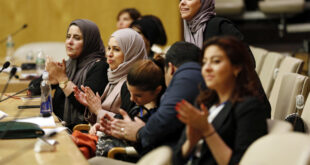Today, Iranian air space is electronically penetrated by numerous radio and TV satellite signals that originate from the US and other countries around the world. In fact, it is probably safe to state that no other nation in the world is targeted by over 20 satellite TV channels and dozens of radio stations broadcasting programs around the clock. These communication channels—many of them controversial—along with the Internet, facsimiles, and telephones have created a unique opportunity for the Iranian expatriates, particularly dissident groups, to openly discuss and debate a slew of political, cultural, and social issues on the global stage. Similarly, these channels provide a platform for the American and Iranian governments to engage in an electronic “war of political rhetoric” and persuasion. This brief essay offers an insight into the US-based and supported as well as Iran-based and supported Iranian satellite TV channels.
According to Mariah Blake (2004, November/December):
Most credit Zia Atabay, a 60-something former rock star known as the “Tom Jones of Iran,” with starting the trend. In March 2000, he launched National Iranian Television, a commercial station in Los Angeles aimed at his compatriots in the United States and Europe. Six months later, an NITV host, Ali Reza Meybodi, received a call from a man in the Iranian city of Isfahan during his live show. The man said he was receiving NITV’s signal. Meybodi didn’t believe him, so he jotted down the man’s number and dialed him back. Sure enough, the man answered. Still doubtful, Meybodi grabbed a piece of fruit from a wooden tureen sitting on the nearby coffee table.
“What am I holding?” he asked. By this time Atabay and others had filtered into the makeshift studio.
“An apple,” replied the caller.
Before long, everyone in the studio was weeping, and calls began pouring in from all over Iran. It turns out NITV reached Iran as the result of a technical snafu; someone at Eutelsat, the French satellite company, had flipped the wrong switch.
Although the above discovery seemingly was accidental, one can argue that the emergence, proliferation, and popularity of exile satellite TV channels in the US and elsewhere is mainly due to the Iranian expatriates’ (1) entrepreneurial zeal, (2) discontent with the Iranian regime, (3) longing for return to the mother land, (4) concern about the poor image of Iran abroad, and (5) attempt to persuade Iranians to demand political reform and regime change. It is perhaps safe to say that most of the owners and operators of the satellite channels departed Iran after the 1979 revolution and, in most cases, have not returned to their homeland for mainly political and ideological reasons. In fact, a sizable number of them were associated closely with or employed in official positions under the previous Pahlavi regime. Others, including some minority groups such as Bahai’s and Jews were marginalized politically or felt uneasy under the new Islamic regime. All in all, the reasons for choosing or being forced to live in exile are complex and multifaceted.
As of this writing, over 20 satellite channels targeting Iran are in operation. Jam-e-Jam (IRIB2) and Khabar (IRINN) are based in Iran and one (Your TV) is based in London. Other channels include Rang-A-Rang, Appadana International, IranX TV, NITV (National Iranian Television), Pars TV, Tapesh TV, Iran TV, Channel Two, Tamasha, PNN (Persian News Network), PEN TV, Didar TV, Markazi TV, Payam TV, Semaye Azadi TV, Tasvir Iran, Omid-e-Iran, LAHSE TV, Salaam TV, Jame-Jam International, and IPN (International Persian Network).
All US-based satellite channels broadcast their programs “live” for 12 hours. The live broadcasts are recorded and then repeated for another 12 hours—qualifying them as 24-hour broadcast channels. In view of the time differences between the US, Europe and Iran, the scheduled 12 hours “live” and 12 hours “repeat” programming makes sense because it enables audiences, in different continents, to view the various programs and channels during a convenient time period (Kamalipour, summer 2003).
Most of the satellite channels, based in the US, can be picked up in Iran by households equipped with illegal satellite dishes, disguised on the rooftops in defiance of the government’s anti-dish stance. Although there are no accurate viewer estimates, reportedly anywhere from 3 to 5 million Iranian households are equipped with receiving dishes. Indeed, a program spoofing the US-based Iranian satellite TV programs is aired on one of the official (government operated and financed) television networks in Iran, which is indicative of the popularity of the exile TV channels among the Iranian population. Furthermore, many viewers seem to consider most of the US-based TV programs as satirical while others believe in any promises made by the self-proclaimed prophets of the air, ranging from self-nominated future presidents of Iran, self-appointed leaders of the liberation of Iran, and self-proclaimed prophets of resurrection. They stress the ancient Persian glories prior to the arrival of Islam and specifically the period in which Zoroastrian religion, with its motto “Good Deeds, Good Thoughts, Good Words,” was considered to be an official religion. In other words, a good portion of programs are reminiscent of the past cultural, social and political virtues. Imbedded in their monologs and dialogues are questions probing how Iran, as an economically and culturally rich nation, “got to this point?” “Why aren’t we liberated/progressive?” “What can we do the change the existing clerical regime?” “Who is going to replace the regime and how?”
To counter the US-based Iranian satellite TV Channels, the Islamic Republic of Iran has established its own channels, two of which (Jame-Jam International—IRIB2 and Khabar-IRINN) are based in Iran and at least two (Salaam TV and Ranga-Rang) that are based in the US. IRIB2 offers a variety of programs around the clock while IRINN is mainly a news channel similar to CNN. Salaam TV is a religious channel and Ranga-Rang offers various entertainment fairs, including some religious programs.
As Hanjoerg Biemer notes, "Persian is one the few regional languages of the world with broadcasts from the external services of all states holding a permanent seat at the UN.” (Biener, 2003). Internationally, over 100 radio and television channels air programs, in Persian (Farsi), to inform, entertain, persuade, agitate, or convert Iranians religiously or politically. Additionally, there are numerous online (Internet-based) radio and TV broadcasts in Persian language. Many major countries in the world, including the United States (Voice of America, Radio Farda, Radio Free Europe/Radio Liberty), France (Radio France International), England (BBC Persian Program), Japan (Radio Japan, NHK Persian) Russia (Voice of Russia), China (China Radio International), Germany (Deutsche Welle), Israel (Radio Israel), and so on broadcast programs aimed at Irans. Furthermore, there are numerous religious broadcasts in Persian. For example, Christian satellite TV programs such as TV Ministry -- operated by the International Antioch Ministries -- broadcasts worship services and other weekly showsin Persian. Others include Radio Nada, Voice of Injil (the Bible), Neda Meohabbat (Voice of Love), Iranian Christian TV, and Simaye Masih TV (Person of Christ TV). The followers of Baha’i faith have established their own radios (Radio Baha’i and Payam-e-Doost), and are in the process of developing television broadcasts.
Although it is not easy to categorize the aforementioned US-based satellite channels, it appears that most of them are opposed to the Islamic regime in Iran and are financially supported through commercials, audience donations, private sources, and sales of time to various ethnic and religious groups (e.g., Iranian Christians, Iranian Jews, Afghanis, and Armenians). Reportedly, some of the channels are supported by the US government, a few by the Iranian government, and some by the pro-monarchy groups, including the son of late Mohammad Reza Pahlavi, Reza Pahlavi, who is viewed as the legal heir to the former king.
It is not clear how these satellite channels can survive in today’s highly competitive and expensive broadcast business (i.e., daily expenses, equipment, studio facilities, wages, insurance, rents, programmers, performers, utilities, satellite transponder fees, uplink facilities, etc.). Perhaps a monthly operational estimate of $100,000, for each station, would be a conservative figure. Naturally, in any enterprise, the financiers influence the overall agenda of a given business, including radio, television, newspaper, or magazine. According to Blake (2004):
There’s been much speculation about where the stations get their funding. The television stations run advertising, but those with political leanings have trouble selling enough ads to cover their costs, which run upward of $1 million a year. Some suggest that the Central Intelligence Agency has served as their silent partner, but station owners insist this isn’t so.
Hence, the questions to ponder are these: (1) To what extent can private interests coincide with public interests? (2) To what extent can private and/or government funded broadcast operations serve viewers’ interests through unbiased, balanced, multicultural, and multifaceted programs? (3) To what extent can the Iranian satellite channels facilitate and fertilize the growth and development of a budding democratic movement -- especially among the youth—in Iran? (4) To what extent can the established satellite channels capture the trust of people, particularly within Iran? (5) To what extent can they practice and tolerate what they preach -- democracy and freedom—by respecting the rights of their competitors and viewers’ opinions? (Kamalipour, 2003).
Although there are no definitive answers to the above questions, it appears that taken together, the US-based Iranian Satellite channels have not been able to gain the same credibility and international influence as the Arabic-language Al Jazeera satellite channel based in the small Persian Gulf kingdom of Qatar. Other Arabic language satellite TV channels, including Al Arabiya, based in the Persian Gulf emirate of Dubai; Al Alam, based in Iran; Al Manar, based in Lebanon; and Alhurra, based in Washington, DC, also have gained attention in the Middle East and elsewhere. In addition to their broadcast programs, these channels distribute their news via their online portals. Interestingly enough, the Iranian-sponsored Al Alam seems to be successful in competing with other satellite news channels aimed at the Arab world.
In general, the bulk of programs on the Iranian satellite channels (excluding the government-run IRIB2 and IRINN channels from Tehran) are more entertaining than informative. Programs consist of (1) talking heads and call-in programs, (2) music videos, (3) panel discussions—normally involving two individuals, (4) commercials, (5) movies, (6) sales of Persian rugs and other products, (7) short satirical sketches, (8) news and information, (9) expert advice from physicians, realtors, and attorneys, (10) sports, (11) documentaries, and (12) movies, especially those produced during the Pahlavi regime. Although all channels seem to address the youth in Iran and abroad, there is a dearth of educational programs for children and adolescents. It seems that at least half of the satellite channels have devoted some of their broadcast times to auctioning/selling Persian rugs and other products (Kamalipour, 2003).
In the midst of globalization and information explosion, communication plays a crucial role at all levels of human interaction, including interpersonal, organizational, regional, national, and international. Hence, the existing Iranian satellite TV channels have the potential to facilitate constructive dialogue, enhance viewers’ knowledge and awareness, and bridge cultural and political gaps within and without Iran. According to Reuel Howe (1990), “… communication means life or death to persons … Both the individual and society derive their basic meanings from the relations that exist between [persons]. It is through dialogue that [humans] accomplish the miracle of personhood and community.”
 Arab Media & Society The Arab Media Hub
Arab Media & Society The Arab Media Hub




